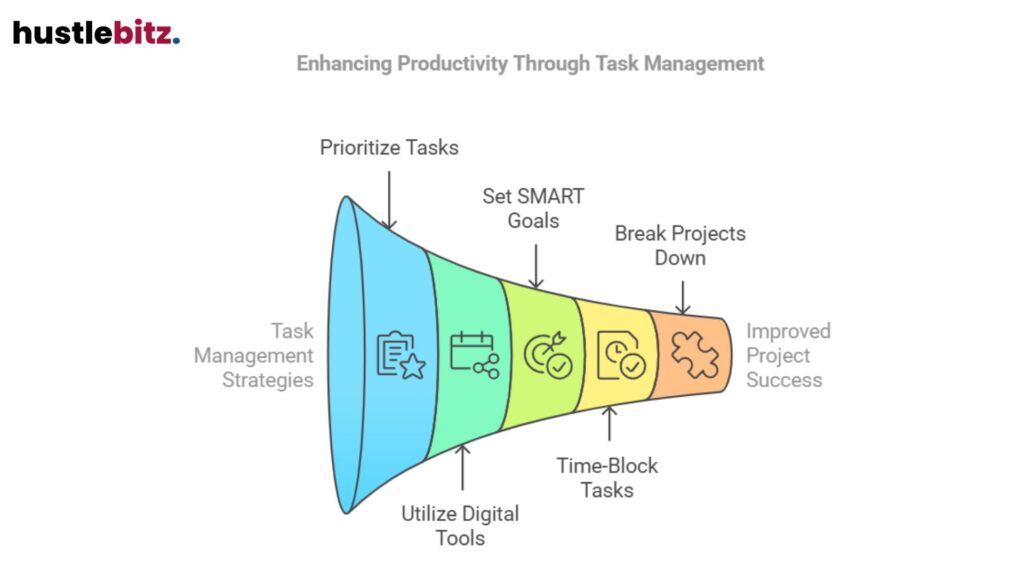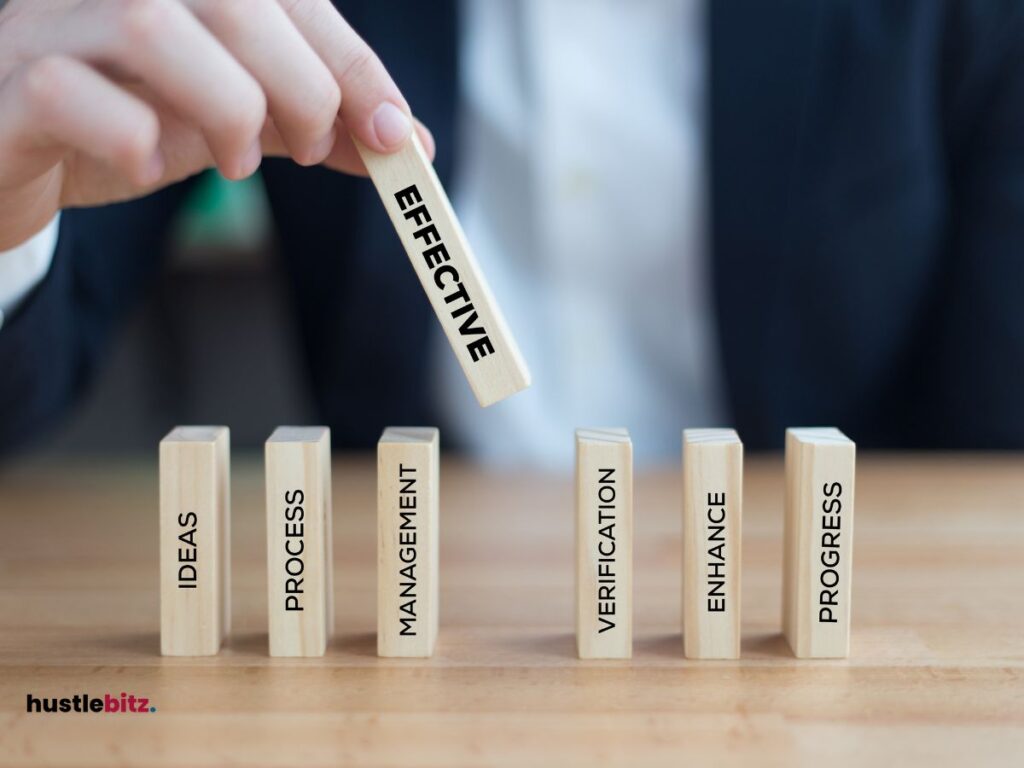Task management strategies significantly enhance productivity by prioritizing tasks and streamlining workflows. By breaking projects into manageable segments, individuals can clarify objectives and track progress effectively. Utilizing tools like the Eisenhower Matrix helps categorize tasks based on urgency and importance, reducing overwhelm. Furthermore, techniques such as time blocking enhance focus and minimize distractions, leading to improved time management. Digital tools play a vital role, facilitating collaboration and providing reminders to keep projects on track. These strategies foster a structured approach that not only boosts efficiency but also encourages accountability among team members. Explore further to uncover additional insights.
Key Takeaways
- Effective task management enhances productivity by prioritizing urgent and important tasks, ensuring focus on high-impact activities.
- Utilizing digital tools streamlines organization, facilitates collaboration, and provides essential features like deadline reminders for better task tracking.
- Setting clear SMART goals aligns daily activities with long-term objectives, fostering motivation and accountability among team members.
- Time-blocking techniques allocate specific time slots for tasks, reducing distractions and improving overall efficiency by minimizing multitasking.
- Breaking larger projects into manageable tasks clarifies objectives, tracks progress, and enhances overall project success rates.

Understanding Task Management

Effective task management is the cornerstone of enhancing productivity, as it enables individuals and teams to prioritize responsibilities, allocate resources efficiently, and achieve their goals systematically. Understanding task management involves recognizing the importance of implementing effective task management strategies that foster organization and focus. By utilizing various task management tools, individuals can streamline their workflows, ensuring that tasks are clearly defined and deadlines are met.
At its core, task management is about prioritizing tasks based on urgency and importance. This prioritization is vital, particularly in environments where time management is important. Without a structured approach, individuals may find themselves overwhelmed, leading to decreased productivity and missed deadlines.
Effective task management strategies involve breaking down larger projects into manageable tasks, which can be addressed sequentially. This not only clarifies what needs to be accomplished but also provides a sense of progress as tasks are completed.
Moreover, task management tools, such as digital applications or simple to-do lists, serve as essential resources for organizing responsibilities. These tools allow individuals to visualize their tasks, set reminders, and track progress, thereby enhancing productivity.
Ultimately, mastering the art of task management empowers individuals to work more efficiently, focus on the most pressing tasks, and achieve their objectives more systematically.
Benefits of Effective Task Management

A well-implemented task management system can significantly enhance productivity, enabling individuals and teams to achieve their goals with greater efficiency and reduced stress. Effective task management allows for clear task prioritization, ensuring that the most important activities are completed first. This strategic approach helps avoid the common pitfalls of procrastination and overwhelm.
One of the primary benefits of effective task management is the ability to streamline workflows. By adopting management strategies to increase efficiency, individuals can reduce time wasted on less critical tasks. Additionally, the use of productivity tools and apps facilitates better tracking of progress and deadlines, which can further optimize performance.
Here are some key benefits of effective task management:
| Benefit | Description |
| Improved Focus | Concentrating on high-priority tasks enhances overall output. |
| Better Time Management | Allocating time effectively minimizes distractions and delays. |
| Enhanced Collaboration | Clear task assignments promote teamwork and accountability. |
Setting Clear Goals

Establishing clear goals is fundamental to enhancing task management and maximizing productivity, as it provides a definitive direction and purpose for both individuals and teams. When you are setting clear goals, you create a framework that informs your daily activities, making it easier to manage your time effectively. Goals serve as benchmarks, allowing you to measure progress and adjust strategies as necessary.
Effective task management strategies begin with the clarity of objectives. By articulating specific, measurable, achievable, relevant, and time-bound (SMART) goals, you lay a solid foundation for success. This clarity not only helps in organizing tasks but also fosters motivation and accountability, as team members understand their roles and responsibilities.
To improve your time management, it is essential to align your daily activities with your long-term goals. This alignment encourages you to focus on what truly matters, helping you to prioritize tasks that contribute to your objectives. When your goals are well-defined, you can easily identify which tasks require immediate attention and which can be scheduled for later, thereby optimizing the use of your time.
Prioritizing Tasks With Ease
Prioritizing tasks effectively is crucial for maintaining productivity, as it allows individuals to focus on high-impact activities that align with their established goals. In today’s fast-paced environment, the ability to prioritize tasks is a fundamental aspect of effective time management. By implementing robust task management strategies, individuals can streamline their workflow and enhance their productivity levels.
One of the most effective strategies to improve task prioritization is to categorize tasks based on urgency and importance. This method not only helps in identifying what needs immediate attention but also clarifies which tasks contribute significantly to long-term objectives. Utilizing tools such as to-do lists, digital planners, or project management software can provide visual cues, making it easier to prioritize tasks consistently.
Another essential aspect of prioritizing tasks is recognizing the impact of time-blocking. By allocating specific time slots for different activities, individuals can create a structured environment that minimizes distractions and promotes focus. This approach allows for better decision-making, as it encourages individuals to evaluate the value of each task in relation to their overarching goals.
Ultimately, effective time management hinges on the ability to prioritize tasks with clarity and purpose. By adopting these strategies to improve task prioritization, individuals can navigate their responsibilities more efficiently, ensuring that their efforts yield the highest possible returns. In doing so, they not only enhance their productivity levels but also foster a greater sense of accomplishment and satisfaction in their work.
The Eisenhower Matrix Explained
An effective tool for enhancing task prioritization is the Eisenhower Matrix, which categorizes tasks based on their urgency and importance, enabling individuals to focus on what truly matters in their workflow. This method, developed by former U.S. President Dwight D. Eisenhower, assists in effective task management by clearly distinguishing between tasks that require immediate attention and those that can be scheduled for later.
The matrix is divided into four quadrants. The first quadrant encompasses tasks that are both urgent and important, often requiring immediate action.
The second quadrant contains tasks that are important but not urgent; these are critical for long-term productivity and should be scheduled thoughtfully.
The third quadrant includes urgent but not important tasks, which can often be delegated to others, allowing for more efficient task management.
Time Blocking Techniques

Time blocking techniques enable individuals to allocate specific time slots for various tasks, thereby enhancing focus and minimizing distractions throughout the workday. This structured approach to time management allows professionals to manage their time more effectively, ensuring that important tasks receive the attention they deserve. By designating specific periods for different activities, individuals can improve their productivity at work and develop stronger time management skills.
Incorporating time blocking into daily routines can significantly streamline workflow and reduce the tendency to multitask, which often leads to diminished efficiency. Below is a table summarizing key elements of effective time blocking:
| Time Block | Task | Duration |
| Morning Focus | Project Development | 9:00 AM – 11:00 AM |
| Midday Review | Email and Communication | 11:00 AM – 12:00 PM |
| Afternoon Strategy | Team Meeting | 2:00 PM – 3:00 PM |
Utilizing Digital Tools

Digital tools play a crucial role in enhancing task management efficiency by providing users with features that streamline organization and facilitate collaboration. In today’s fast-paced work environment, adopting effective task management strategies is essential for optimizing productivity. Productivity apps and time management tools are indispensable resources that help individuals and teams manage their tasks more effectively.
These digital tools often come equipped with various functionalities, such as task prioritization, deadline reminders, and progress tracking, which serve to improve overall management skills. By integrating these features into daily routines, users can better allocate their time and resources, ensuring that critical tasks are completed efficiently. For instance, utilizing a productivity app can help individuals break down larger projects into manageable tasks, making it easier to maintain focus and motivation.
Moreover, many of these tools offer collaborative features that facilitate communication among team members. This not only enhances productivity but also fosters a more cohesive work environment where everyone stays aligned with their objectives. Real-time updates and shared task lists allow teams to coordinate efforts effortlessly, reducing the chances of miscommunication and project delays.
Final Thoughts
Effective task management is the backbone of productivity. By prioritizing tasks, setting clear goals, and utilizing time management techniques like time blocking, you can streamline your workflow and focus on what truly matters. Digital tools further enhance this process by providing the organization and collaboration features needed to keep projects on track. These strategies not only improve efficiency but also reduce stress and foster a sense of accomplishment. Implementing these task management practices can transform how you approach your work, leading to sustained productivity and success in achieving your goals.




